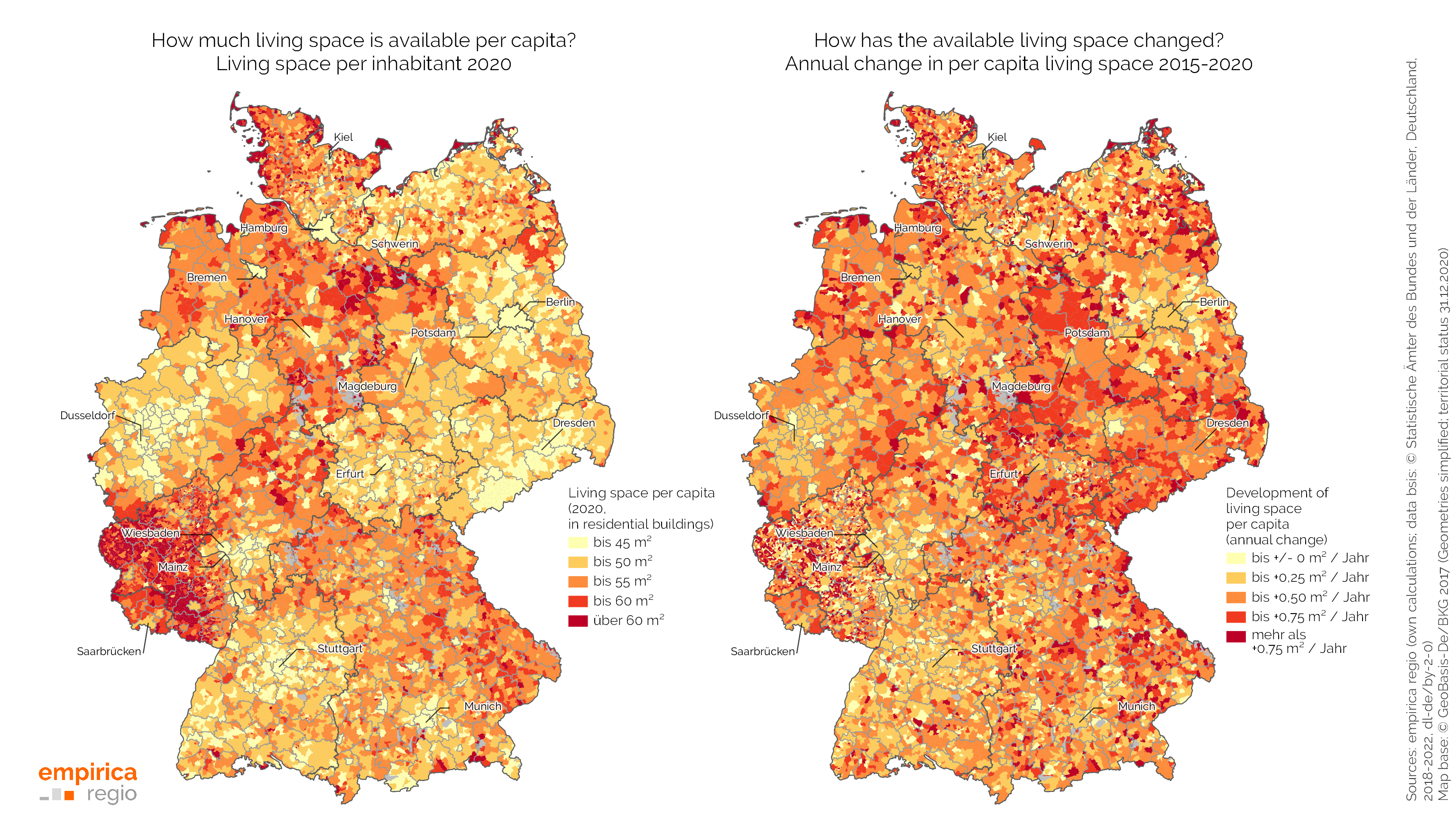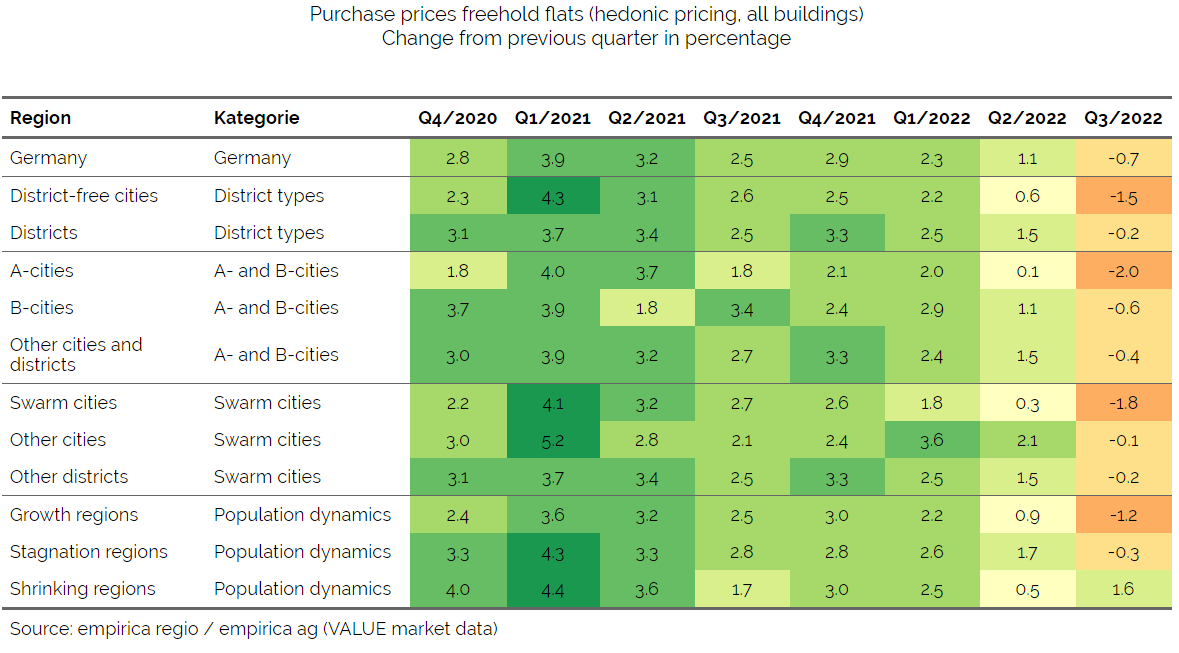Special analysis on available living space in Germany
The economic and real estate data provider empirica regio GmbH has determined the per capita residential space consumption of all German municipalities with 400 or more inhabitants. Almost 9,000 municipalities and 107 independent cities were analysed. The results show that popular holiday destinations in particular consume a lot of living space per inhabitant, but people in rural regions also have a particularly large amount of living space at their disposal. In the German metropolitan areas, on the other hand, people are moving closer together and living on less living space.
Special effects: Holiday homes and US bases drive statistical land consumption
According to the data, especially on the German North Sea islands of Sylt and Föhr, few people live on a lot of space. Kampen on Sylt is the lonely leader with 264 square metres per inhabitant. It is followed by Nieblum on Föhr and Wennigstedt-Braderup, also on Sylt, with 120.9 and 108 square metres of living space per capita respectively.
Many municipalities with a particularly high statistical land consumption are also located in the vicinity of foreign military bases, because due to their NATO troop status, soldiers and their family members are exempt from compulsory registration. This particularly affects many municipalities in Rhineland-Palatinate in the vicinity of the Ramstein and Spangdahlem bases. In order to adjust both special effects for the evaluation, municipalities with a share of 5 % or more of holiday homes in all residential units (basis: Census 2011) and all municipalities within a radius of 20 km around Ramstein and Spangdahlem except the cities of Kaiserslautern and Trier were filtered out.
The other municipalities with the highest residential space consumption per capita are then Beuren (Eifel) (75.2 m²/capita) and Bremm (74.6 m²/capita) in Rhineland-Palatinate and Aventoft (73.6 m²/capita) in Schleswig-Holstein. The typical municipality with a very high housing consumption of more than 65 m² per capita usually has up to 1,200 inhabitants, is located in a rural area and lost population in the last five years. Many of these municipalities also had a vacancy rate of 5 to 10 % in the 2011 census.
Bliesdorf and Raunheim are the most economical municipalities in terms of living space
In contrast, the municipalities of Raunheim in Hesse and Bliesdorf in Brandenburg (34.3 m²/capita) use particularly little living space per inhabitant. Bringing up the rear in the evaluation are the municipalities of Friedland and Osterheide in Lower Saxony (28.4 and 12.5 m²/capita respectively). In these municipalities there are larger communal accommodations, which again distorts the statistics.
At the end of the list with low living spaces per capita are many medium-sized and large cities. It is striking that besides Stuttgart (37.6 m²/capita), four cities from the Rhine-Main region have particularly low values: Dietzenbach (37.5 m²/capita), Frankfurt am Main (37.4 m²/capita), Rüsselsheim am Main (37.3 m²/capita) and Offenbach am Main (35.0 m²/capita). In general, people in tight housing market regions and the large metropolises have to squeeze into less living space per capita. In rural regions according to the EU definition (Degree of Urbanisation), the per capita consumption of living space is highest at 51.4 m². In cities, on the other hand, it averages 40.9 m². In between are so-called smaller cities and suburbs with 47 m² per capita. At the same time, per capita living space increased the most in rural areas between 2015 and 2020 (+3.7%) and the least in the core cities (large cities) (+1.5%).
Top cities have exhausted residential space consumption
In the top cities, on the other hand, the development of residential space consumption is consistent. Berlin and Cologne have not seen any growth. Per inhabitant, 38.9 square metres have been available there for years. Frankfurt am Main, Munich, Hamburg, Düsseldorf and Stuttgart were able to record a manageable growth in residential space consumption per capita: Overall, the residents there have two per cent more space than in 2015. In Düsseldorf, the residential space consumed per capita is the highest of the top 7 cities at 41.6 square metres.
Hamburg (39.4), Munich (38.6), Berlin and Cologne (38.9) and Stuttgart (37.6) follow behind. Frankfurt has the least space. They have to make do with 37.4 square metres per capita. Leipzig, Hanover, Marburg and Giessen consume only marginally more living space per capita than the top 7 cities.
Press contact
Jasper Radü
PB3C GmbH
Tel.: +49 40 5409084-21
radue@pb3c.com




